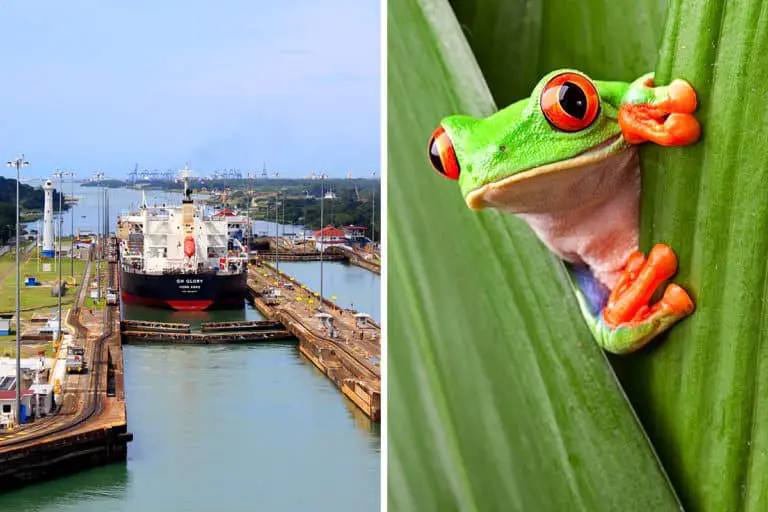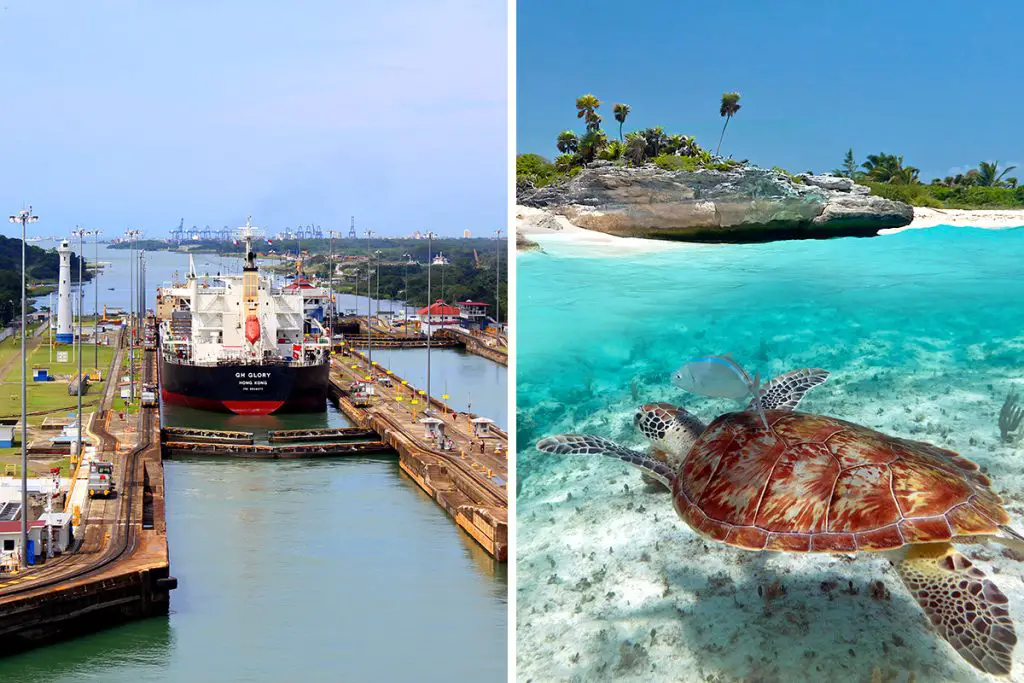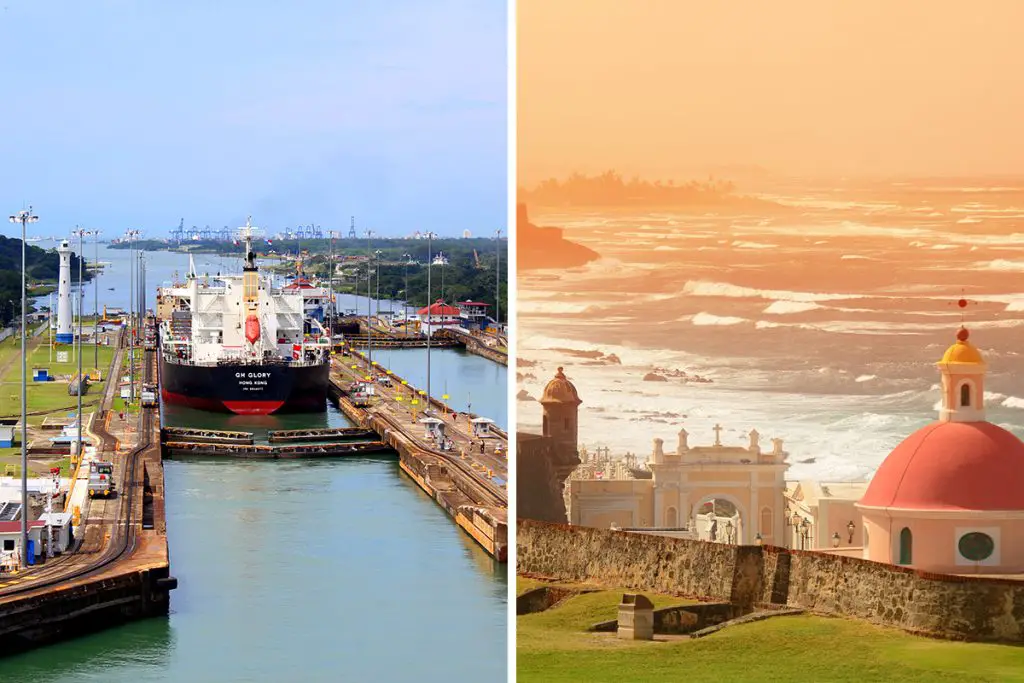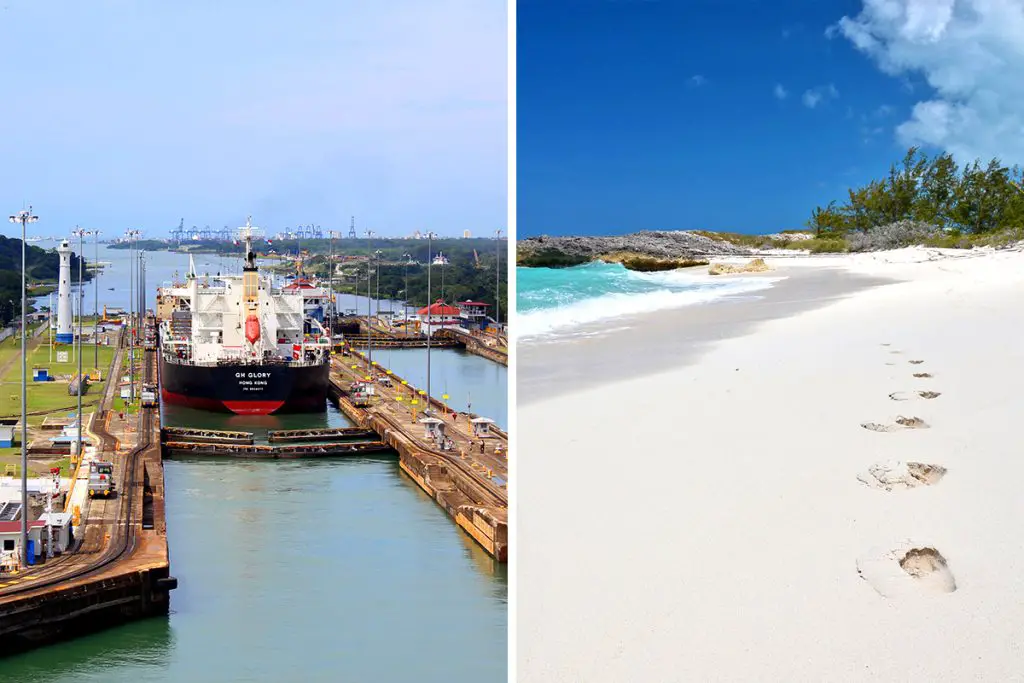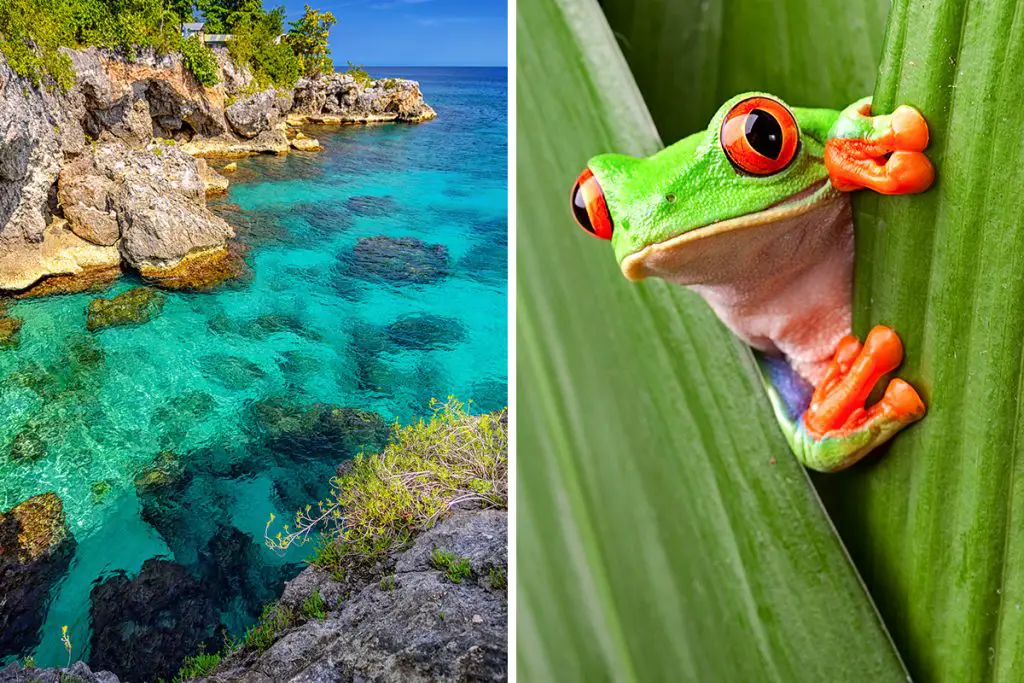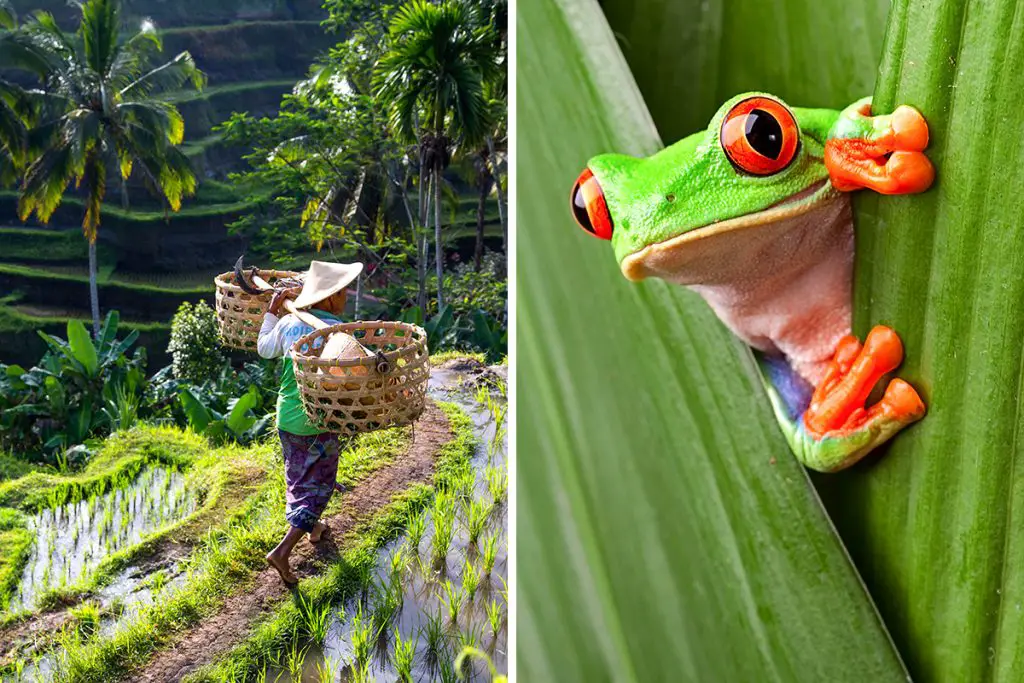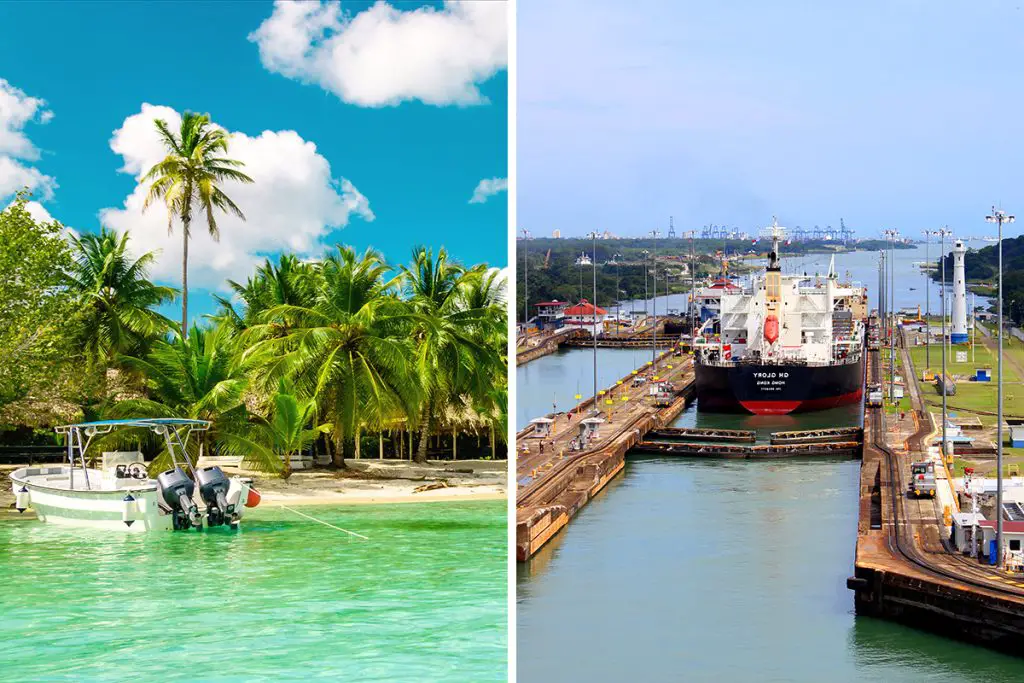As you lay out each of their attractions and allures, you can’t help but want to see both, and you know it’s a smart idea since the juxtaposition of parallels and contrasts between Costa Rica and Panama is worth the roundtrip (or onward) ticket. Not to mention that they’re neighbors, so picture how much ground you’ll be able to cover.
Panama
Just when everybody thought that the Caribbean is the brightest, if not the only shining star in the American tropics, Central America’s luster slowly shines through the marquee of many of the Caribbean’s best names. And in the growing light of Central America, Panama is making a big splash.
Apart from steady fame over the years, thanks to the Panama Canal, there’s more to Panama than just a revolutionary manmade marvel. From endless summer days, great outdoors, wild adventures in a seemingly lost world, and the famous silver city of Panama City, and all its cosmopolitan charms, this Central American nation is up and coming, or rather, already there and going big.
What Makes Panama Unique
The Legendary Canal
Let’s face it, you have heard of Panama because of the manmade marvel that is the Panama Canal. An ambitious maritime engineering feat that has greatly aided and very much spearheaded the steady development of the country’s economy. The canal today is more than just some pioneering structure, but is now a world-class tourist attraction that has drawn many ordinary curious tourists, the occasional engineering fanatic, and maritime enthusiasts.
The French attempted to build the canal first, but disease and accidents killed an estimated 22,000 men before the project was abandoned and handed over to the United States in 1914. Until the end of the twentieth century, the Americans were in charge. Panama hasn’t shied away from flexing its muscles since taking power in 1999. Fees for passing ships have more than tripled in the last five years, to about $450,000 for a vessel carrying 4,500 containers.
This marvelous canal connects the Atlantic and Pacific oceans via the Caribbean Sea, and it spans over 50 miles (80 km) through some of Panama’s most beautiful scenery. You can take a half-day or one whole day of transit excursion from Panama City to see the entire length of this wonderful river. A journey on the Panama Canal Railway, which runs alongside the canal through lush rainforest, is another thrilling way to observe this manmade marvel. Two land-based platforms, the Miraflores Visitors Center and the Colon Panama Canal Expansion Observation Center are not to be missed on any tour.
Wallet-Friendly
Overshadowed by the giants of the Caribbean, and quite possibly its northern neighbor, Costa Rica, Panama’s smaller tourism demand may have given it quite a leeway to be a wallet-friendly destination. Panama is known for prices that won’t break the bank, especially for tourists coming from the US, Canada, or Europe. The whole financial arrangement with the country using US dollars makes it cost-effective for a lot of its tourist demographic.
You can easily get a budget of around 49 to 63 USD a day when vacationing to Panama. However, that may change depending on what kind of traveler you are; a backpacker can get around the costs with just a weekly budget of 400 to 500 USD for a week, for a single person. If you’re from the US especially, you could notice that the price can come cheap. If you do want to splurge on costs, you can also find opulent pleasures around the capital of Panama City, which is the most costly place in the entire country.
Biodiversity
An interesting fact: Central America is one of the most extremely biodiverse and naturally gifted places on earth, and Panama has a great bounty of its earthly beauty. Just like its neighbor, Costa Rica, Panama also aims to protect its varied ecosystems. Well, if you have rich rainforests, mangroves, beaches, mountains, and cloud forests, covering most of your territory, you’d make sure to protect it. Panama’s 14 national parks are just one telltale of it all.
The Central American country is home to over 200+ mammal species including famous big cats such as jaguars and pumas, as well as several species of monkeys, and other small to medium-sized mammals. Also thanks to its bicoastal setting, sandwiched by the Caribbean Sea on one side and the Pacific Ocean on the other, Panama is also home to a vastly diverse array of marine life. From exotic turtles like the Leatherback, and the Olive Ridley, to the gentle Humpback whale, along with whale sharks, nurse sharks, and the famous bottle-nosed dolphin.
Panama is covered and speckled with lush forests and many natural gifts that the country probably has one of the most number protected areas such as national parks, and conservations. Thanks to the government’s increasing efforts in nature conservation, the country now has over 14 national parks leaving 22% of Panama’s land protected. Volcán Bar National Park, La Amistad International Park, Soberana National Park, and Isla Coiba National Park are among the country’s most popular national parks.
Endless Sunny Days, Endless Vacation
Apart from the tropics’ relatively sunny warmer days perfect for the seemingly eternal summer, and a bit of rain during the rainy season, Panama holds very little risk of being hit by tropical storms.
Panama lies just outside the infamous Atlantic Hurrican Belt, leaving plenty of opportunities for holidaymakers and travelers to enjoy the country’s promise of eternal summer. The country’s gorgeous weather is hard to beat with its dry season that can climb up to the 30s C, or 90s F, providing ideal conditions for a wide range of activities such as swimming, diving, snorkeling, river tours, forest treks, and a whole lot more.
And of course, Panama has the ideal setting that could go perfectly with its eternal sunshine. Being a hybrid of the Caribbean and Pacific coasts, the country is poised to provide everyone a top-notch beach life. Lounge and frolic around picturesque beaches, or go under the fabled blue sea by scuba diving and swimming with the local marine life, or snorkel around rainbow reefs. And as for watersport enthusiasts, expect to have some fun here as well.
The Great Outdoors
With great outdoors and nature, comes a great deal of wonders to revel upon, and things to do. The country is all about discovery and braving great feats. You can explore around the ruins of several Spanish forts speckled across various shores in the Caribbean coasts, or trek, hike, and boat deep into the lush forests and indigenous territories of the country. And as you do that, expect to see the gifts of nature that have added to Panama’s overall value. From rich rainforests flora and fauna to the extensively diverse wildlife you might encounter.
In the highlands of Santa Fé, soak up the spray of towering waterfalls. Through community tourism, you can learn about one of Panama’s seven indigenous peoples. In the Guna Yala, you can live out your pirate fantasies or relax on a remote beach in the Peninsula de Azuero. Return the howl to the animals that share the canopy. Panama can be as wild as you’d like.
Costa Rica
Pura Vida, or pure life, is the motto of this evergreen island, which remains true to its celebration of the beauty of a life spent in harmony with nature. Costa Rica is unquestionably one of the most well-known tourist destinations in Central America and the entire tropical world. Costa Rica is a fascinating Latin American country to visit, with all of its native highs best experienced in nature and in the country’s culture.
Costa Rica is focused on ecotourism and the biodiversity of its innards, in addition to the conventional elements of a tropical beach vacation. There’s more to this Latin American country than beaches and towns; it’s one of the greenest countries you’ll ever visit, thanks to its incredible biodiversity and ecological performance index. On top of the normal beach activities, you’ll most likely do in a tropical trip, there’s trekking, bird watching, cave exploring, and wall/rock climbing to do.
What Makes Costa Rica Unique?
Pura Vida
“Pure Life,” as it is translated, is a heartfelt Costa Rican cultural philosophy that characterizes how people live on a daily basis. This entails living as naturally as possible, with a strong emphasis on simplicity and, of course, pleasure. After all, what matters are the simplest things. Pura Vida pervades their culture, which places high importance on and protects the land’s most valuable resource: nature.
Costa Ricans, or Ticos, are able to live life without a fuss because of the Pura Vida ideology. Simply live life without difficulties, with a light sense of delight and respect for the environment. This concept and philosophy were also employed by Ticos when welcoming tourists, allowing them to experience the true lightness of living simply alongside Mother Nature.
Biodiversity Extravaganza
Over 30% of the country is covered by protected and conserved national parks, providing enough space for the country’s flora and fauna to thrive and grow. Costa Rica is thus one of the world’s most environmentally conscious countries. When you’re traveling through the deep green forests, you may expect to witness a diverse range of animal and plant species.
Costa Rica’s territory is so small that it only spans 0.03 percent of the Earth’s surface, but it is nonetheless one of the world’s top 20 biodiversity-rich countries. This means that there are more species in Costa Rica per 1,000 square kilometers than there are in a comparable region in a huge country like Brazil or Colombia.
Yet Another Beach Capital
Costa Rica is not only rich in nature and biodiversity, but it also showcases its beaches and the culture that surrounds them, thanks to its location and topography. Beautiful beaches with their unique eccentricities can be found here, while surfing and diving are popular activities in the Central American country.
Costa Rica is the third most popular surfing destination, after Hawaii and Indonesia. The reasons are simple: great surf all year, good weather, warm water, friendly people, and reasonable prices. Pura Vida, for sure.
In addition to swimming on beaches and surfing, diving is a great way to spend time in Costa Rica. Scuba divers will find Costa Rica to be a perfect destination. The majority of these sites are located in wildlife-protected regions around the country, including the well-known Cocos Island National Park, which is also a UNESCO World Heritage site.
The Pacific coast of Costa Rica is one of the world’s top five advanced scuba diving locations. Animals found in the area include hammerhead sharks, humpback whales, bottlenose dolphins, hawksbill turtles, and a variety of coral types.
Land of Earth & Fire
With all of its greenery and thick, lush forests, it’s no surprise that the country is littered with volcanoes, with all of the volcanic ingredients feeding or even giving birth to the forests surrounding.
With over 200 volcanic formations scattered around the country, you may expect to discover some intriguing hiking routes nearby. The Arenal Volcano, which has become a tourist attraction, is one of the most popular volcanoes in the country. The dormant cone volcano is directly above the town of La Fortuna, allowing hiking trips along the original lava flow trails.
Adventure Buffet
If you’re the thrill-seeking sort, or simply an adventurous tourist, Costa Rica and its natural beauty will likely captivate you. The nation offers every imaginable outdoor activity, from trekking volcanoes to surfing, diving, horseback riding, and ziplining, to the adventurous explorer. Take it from a slew of YouTubers who have visited and lived in Costa Rica.
In such a small country, you can easily find something exhilarating or adventurous to do no matter where you are. Rivers and lakes provide opportunities for river rafting, tubing, and fishing; forests provide opportunities for trekking; caves provide opportunities for exploration; beaches and seas provide opportunities for surfing and diving, and the rest of the interiors provide opportunities for horseback riding and even ziplining through rainforests.
Should I Go to Costa Rica or Panama?
Whenever you’re in the best of Central America, it isn’t a question of which is which, or should or shouldn’t, the question is when will you go? Costa Rica and Panama best represents why Central America shouldn’t be criminally underrated. These Central American darlings definitely prove that underrated destinations can have the best of history, culture, natural beauty, and manmade wonders.
Costa Rica is best for the nature-loving, pro-peace, chill, laidback traveler. The country itself is built by Mother Nature and runs on Pura Vida – a way of living that promotes the kind of life where kindness and “taking things slow” are king. And Panama, on the other hand, is big on business and commerce, with a side of outdoor adventures, best-of-both-worlds beaches, and marvelous manmade feats, the country is best for the really curious and eager tourists.
As you lay down each of their draws and charms, you can’t help but want to go to both, and trust that it’s a good idea because Costa Rica and Panama’s juxtaposition of similarities and differences are worth the roundtrip (or onward) ticket. Not to mention, they’re neighbors – imagine the ground you can cover.
FAQ
Is Panama Similar to Costa Rica?
Panama and Costa Rica, being both independent nations in their own right, have certain differences in their local cultures, attitudes, customs, and way of life. However, thanks to their fair share of similarities as both are Latin American countries, it is expected to see a number of similarities. Having shared histories of being under Spanish colonial rule for an extensive period, a lot of cultural overtones can be observed in many of the Latin American countries.
What Is the Difference Between Costa Rica and Panama?
Costa Rica and Panama’s similarities lean more towards the Hispanic or Latino cultural overtones, on top of their bountiful natural beauty. But when you take a careful look through a more focused lens, you can see that local cultures, attitudes, customs, and ways of life can set them apart in a very obvious sense.
Their respective overall vibe has to be the most obvious difference. Costa Ricans are known for their easygoing demeanor and philosophy of life that emphasizes happiness. Pura Vida, as they say. It’s a simple place to get around and meet people. The Ticos are incredibly hospitable and like conversing with visitors. Panamanians are similar and easy to communicate with.
Costa Rica has little to offer in the way of cultural tourism, and most of it is concentrated in central San Jose, where few tourists visit. Panama, on the other hand, boasts several fascinating attractions, most of which are concentrated in the capital. The Panama Canal, one of the world’s most magnificent technical feats, the ruins of Old Panama, and the Casco Antiguo are all worth visiting. San José isn’t nearly as exciting as Panama City.
Is Panama or Costa Rica Cheaper?
Panama and Costa Rica may seem more or less the same when it comes to costs, but Panama can be 10 to 20% cheaper than Costa Rica. Certain purchases like essential goods can seem to cost the same in both countries. An essential purchase like a liter of milk costs around 1 to 2 USD in both Panama and Costa Rica, as well as half a liter of water. However, certain services like a one-way transport ticket can cost half a USD in Panama, and a whole dollar in Costa Rica.
Even just by a small margin, you can easily see the disparity of costs between Costa Rica and Panama. Looking up costs and prices can help you get a good overview of what to expect, and how much to budget – from there, you can decide which one suits your wallet better.
Is Panama More Developed Than Costa Rica?
From infrastructure and urban development, Panama seems to be the more developed thanks to the economic boom the country has been experiencing over the recent years. You can see highly urbanized areas and public facilities across Panama City, and other competitive major cities in the country. Panama also holds the highest GDP in the Central American region.
However, Costa Rica may come only second to Panama, it is considered to be the most “developed” of the Central American countries, with a relatively high GDP per capita and the greatest indices for life expectancy at birth, infant mortality rate, and adult literacy rate among the Central American countries.
Is Panama Richer Than Costa Rica?
If you look at the latest statistical data, Costa Rica has a higher GDP than Costa Rica making it “richer” of the two. Costa Rica has an apparently higher GDP of 61.45 compared to Panama’s 52.94.
Is Costa Rica or Panama Safer?
When it comes to elements affecting public safety, Panama rates higher than Costa Rica on the Safety Scale, according to recent data. Panama and Costa Rica are two of the safest, or at least the countries with the lowest crime rates in Central America if not all of Latin America. When many aspects such as crime rates, health difficulties, and public order are taken into account, Panama and Costa Rica are considered the most well-ordered countries on their side of Latin America.
Costa Rica vs. Panama Crime
Both Costa Rica and Panama fair moderately when it comes to the level of crime. But Costa Rica scores higher than Panama in the crime index with a ten-point difference. Costa Rica’s most problematic crimes involve grand theft auto, drug trafficking, property crimes, assault, armed robbery, and corruption – which all scored concerningly high.
Costa Rica vs. Panama Beaches
The best common thing about Costa Rica and Panama, and most of Latin America has to be their absolutely gorgeous beaches all over. Costa Rica offers several beautiful beaches, some of which have been named among the greatest in the world on multiple occasions. The amazing thing about Costa Rican beaches is that almost all of them are rather nice, and several of them are simply stunning. You may choose from kilometers of beautiful beaches in Costa Rica.
In Panama, the San Blas Islands and all of their beaches, as well as Pollo Beach in Bastimentos, are the region’s most beautiful beaches. They’re picture-perfect, with nearly blue-fluorescent water, soft sand, and snorkeling spots just off the beach. That doesn’t get any better. The well-kept attractiveness of Panama’s beaches, owing to fewer visitors than Costa Rica’s, may be an advantage.
Surfing in Panama vs. Costa Rica
Panama and Costa Rica both have similar advantages when it comes to beaches. Their coastlines give them access to the Caribbean and Pacific tides. With each surf area, you’ll get a unique experience. Both countries are ideal for surfers of all skill levels.
Costa Rica is well-known as a surfer’s paradise. It boasts some of the most consistent surf all year, with little seasonal variation. Even though there are many tourist projects, the area might be inexpensive if you know what you’re doing. It is also generally cooler and less humid than many of its nearby neighbors.
Any swell from the Pacific is picked up by Costa Rica’s Pacific coast. Many of the waves that arrive here originate in the southern hemisphere and produce a wide range of swells. From May to December, there are also more frequent waves coming from the northwest.
Panama is without a doubt one of the world’s top beach getaways. If you like surfing, it’s one of the largest buffets of diverse beaches, each with its own unique offerings. Everywhere you travel, you’ll notice how distinct each location is from the next.
Surfing in Panama has a number of perks. The main advantage is that Panama has created roads to beach resorts throughout time. Almost all locations are within a few hours of one another, allowing you to hop around as often as you desire.
Costa Rica’s beaches, on the other hand, are more developed than Panama’s. It’s a nature lover’s heaven, with easy access to a variety of activities within a short distance of the coast. Its beautiful beaches will enchant you while you relax and challenge you while you surf.
Panama vs. Costa Rica Nightlife
Both countries are great for partying and drinking at night, however, if you really want to taste the gist of the true nightlife scene of these destinations you have to be more specific. For Costa Rica, its top contenders for great nightlife are Jaco, and the capital of San Jose, while Panama only has the capital of Panama City. People who have been to both countries will almost always say that Panama City, being the more urbanized city among the three, offers the best scene. Many discos, pubs, and upscale restaurants may be found in Panama City. There are solutions to suit everyone’s preferences and budget.
Panama vs. Costa Rica Wildlife
Costa Rica is one of the most biodiverse places on earth on top of its conservation efforts, and ecotourism, there is no doubt that Costa Rica takes the bag as having the best wildlife. In Costa Rica, finding wildlife is considerably easier than in Panama. Costa Rica also benefits from the fact that it has been a tourist destination for longer than Panama and has a more developed tourism sector.
Where Is Costa Rica and Panama?
Costa Rica and Panama are located in Central America, bridging the Americas. Both countries are also ideally located in-between two bodies of water, sandwiched by the Caribbean Sea to the north, and the Pacific Ocean to the south.
Is Costa Rica Near Panama?
Costa Rica is located right next to Panama, sharing borders right at the heart of Central America. Panama is the isthmus that seemingly connects North and South America, bordered by Colombia to the south, and Costa Rica to the north.
How Far Is Panama From Costa Rica?
Costa Rican and Panama literally border each other – with Panama located just southeast of Costa Rica.
Is Costa Rica a Part of Panama?
Costa Rica was never a part of Panama, at least not in history. In the time of the Federal Republic of Central America, to which Costa Rica used to be a part, Panama was already a separate body.
Is There a Border Between Panama and Costa Rica?
The Costa Rica–Panama border runs for 348 kilometers or 216 miles between Costa Rica and Panama. The Echandi-Fernandez Treaty, signed in 1941, established the current border. The border between the two countries goes via the Cordillera Central, which stretches between the Pacific and Caribbean coasts.
Can You Travel From Panama to Costa Rica?
You can travel between Panama and Costa Rica, in one of two common ways. By road, either by rental car or bus, and by air, via the many airlines that offer direct flights.
How to Travel From Panama to Costa Rica
There are two main ways to travel between Panama and Costa Rica. By car or bus, and by air, thanks to the several airlines that offer direct flights. If you’re going by land, you can brave the long road between borders and cities, by taking a bus, or by driving yourself. However, it may take longer and might be more costly than you anticipated. You can take a bus to Costa Rica from Panama with bus operators such as Expreso Panama, Tica Bus, Panachif, Autotransportes MEPE, Terminales Panama David, and many more. If you prefer flying, you can book flights from Panama City to San Jose via Avianca, Copa Airlines, and Air Panama.
Can I Fly From Panama to Costa Rica?
You can take the fastest route to Costa Rica from Panama by flying which can be both time and cost-effective. Check out air carriers such as Avianca, Air Panama, and Copa Airlines.
How Long Is the Flight From Panama to Costa Rica?
With such a short distance, thanks to them being neighbors, the average flight time should take around an hour or so.
What Airlines Fly Panama to Costa Rica?
You can fly to Costa Rica from Panama with Avianca, Air Panama, and Copa Airlines.
Is There a Bus From Costa Rica to Panama?
You can take a bus from Costa Rica to Panama, and vice versa. Hop into any of the available bus operators such as Expreso Panama, Tica Bus, Panachif, Autotransportes MEPE, Terminales Panama David, and many more.
How Much Is a Bus From Panama to Costa Rica?
A one-way ticket can cost around 80 USD.
Can You Drive From Costa Rica to Panama?
You can actually drive from Costa Rica to Panama easily as they just border each other. One of the many routes you can take to get across is the Pan-American Highway, one of the most common ways to travel from North America to Central America that ends in Panama at the Darien Gap.
Can Americans Drive From Costa Rica to Panama?
Americans can drive from Costa Rica to Panama, as long as they have a valid international driver’s license, not a US one.
How Long Is the Drive From Panama to Costa Rica?
Depending on the factors along the road, on average you can drive from Panama up to Costa Rica for more than 12 hours.
Is It Easy to Drive From Costa Rica to Panama?
If you stick through main highways across the two counties, driving should be easy. Just be sure to have all the documents needed on border checks, and confirm the condition of your vehicle.
Is It Safe to Drive From Costa Rica to Panama?
Just be sure to remember the proper driving etiquette, bring a working GPS, necessary documents, and a well-conditioned vehicle. The highways that can get you across Costa Rica and Panama are generally safe, just try to avoid driving at night where road hazards double.
Is Panama or Costa Rica Nicer?
It all depends on how you look at it, because while both places appear to be similar on the surface, their variances are what make them unique and, in many ways, beautiful. To determine which is which, you must first choose what you desire from a travel place. To notice the beauty in something, you need the correct kind of eyes. Costa Rica and Panama are both fascinating and worthwhile travel destinations.

